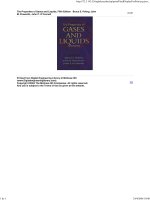Ship Construction Fifth edition D. J. Eyres M.Sc., F.R.I.N.A pptx
Bạn đang xem bản rút gọn của tài liệu. Xem và tải ngay bản đầy đủ của tài liệu tại đây (17.15 MB, 366 trang )
Ship Construction
Shca01.fm Page i Tuesday, March 27, 2001 12:10 PM
Shca01.fm Page ii Tuesday, March 27, 2001 12:10 PM
Ship Construction
Fifth edition
D. J. Eyres
M.Sc., F.R.I.N.A.
Formerly Lecturer in Naval Architecture
Department of Maritime Studies
Plymouth Polytechnic
(now University of Plymouth)
OXFORD AUCKLAND BOSTON JOHANNESBURG MELBOURNE NEW DELHI
Shca01.fm Page iii Tuesday, March 27, 2001 12:10 PM
Butterworth-Heinemann
Linacre House, Jordan Hill, Oxford OX2 8DP
225 Wildwood Avenue, Woburn, MA 01801-2041
A division of Reed Educational and Professional Publishing Ltd
A member of the Reed Elsevier plc group
First published 1972
Second edition 1978
Third edition 1988
Fourth edition 1994
Reprinted 1997, 1998, 1999, 2000
Fifth edition 2001
© D. J. Eyres 1972, 1978, 1988, 1994, 2001
All rights reserved. No part of this publication
may be reproduced in any material form (including
photocopying or storing in any medium by electronic
means and whether or not transiently or incidentally
to some other use of this publication) without the
written permission of the copyright holder except in
accordance with the provisions of the Copyright,
Designs and Patents Act 1988 or under the terms of a
licence issued by the Copyright Licensing Agency Ltd,
90 Tottenham Court Road, London, England W1P 0LP.
Applications for the copyright holder’s written permission
to reproduce any part of this publication should be addressed
to the publisher
British Library Cataloguing in Publication Data
Eyres, D. J. (David John)
Ship construction – 5th ed.
1. Shipbuilding 2. Naval architecture
I. Title
623.8
′
2
Library of Congress Cataloguing in Publication Data
Eyres, David J.
Ship construction/David J. Eyres. – 5th ed.
p. cm.
Includes bibliographical references and index.
1. Shipbuilding. 2. Naval architecture. I. Title.
VM145.E94 2001
623.8
′
3–dc21
2001025515
ISBN 0 7506 4887 2
www.bh.com
Typeset in India at Integra Software Services Pvt Ltd, Pondicherry, India 605005, www.integra-india.com
Printed and bound in Great Britain by MPG Books Ltd, Bodmin, Cornwall
Shca01.fm Page iv Tuesday, March 27, 2001 12:10 PM
Contents vii
Preface ?
Acknowledgments I
Part 1 Introduction to
Shipbuilding 1
1 Basic Design of the Ship 1
Preparation of the Design 1
Information Provided by Design 4
Purchase of a New Vessel 6
Ship Contracts 7
2 Ship Dimensions and Form 2
3 Development of Ship Types 3
Dry Cargo Ships 3
Bulk Carriers 19
Oil Tankers 21
Passenger Ships 26
Part 2 Materials and Strength of
Ships 2
4 Classification Societies 4
Lloyds Register Classification Symbols 34
Structural Design Programs 35
Periodical Surveys 36
Damage Repairs 38
5 Steels 5
Manufacture of Steels 5
Heat Treatment of Steels 41
Steel Sections 42
Shipbuilding Steels 42
High Tensile Steels 43
Steel Castings 44
Steel Forgings 44
6 Aluminium Alloy 6
Production of Aluminium 47
Fire Protection 50
7 Testing of Materials 7
Classification Society Tests for Hull Materials 53
8 Stresses to which a Ship is Subject 8
Vertical Shear and Longitudinal Bending in Still
Water 8
Bending Moments in a Seaway 8
Longitudinal Shear Forces 58
Bending Stresses 58
Transverse Stresses 62
Local Stresses 62
Brittle Fracture 63
Fatigue Failures 66
Part 3 Welding and Cutting 3
9 Welding and Cutting Processes used in
Shipbuilding 9
Gas Welding 70
Electric Arc Welding 72
Other Welding Processes 81
Cutting Processes 84
10 Welding Practice and Testing Welds 10
Welding Practice 10
Welding Sequences 93
Testing Welds 96
Non-destructive Testing 98
Classification Society Weld Tests 102
Part 4 Shipyard Practice 4
11 Shipyard Layout 11
12 Ship Drawing Offices and Loftwork 12
Loftwork Following Drawing Office 114
13 Plate and Section Preparation and
Machining 13
Plate and Section Preparation 13
Plate and Section Machining 120
Frame Bending 126
14 Prefabrication 14
Sub-assemblies 133
Unit Fabrication 133
Outfit Modules 135
Unit Erection 136
Joining Ship Sections Afloat 138
15 Launching 15
End Launches 15
Side Launches 151
Building Docks 151
Ship Lifts 152
Part 5 Ship Structure 5
16 Bottom Structure 16
Keels 16
Single Bottom Structure 157
Double Bottom Structure 157
Machinery Seats 167
17 Shell Plating and Framing 17
Shell Plating 17
Framing 170
Tank Side Brackets 172
Local Strengthening of Shell Plating 172
Bilge Keel 178
18 Bulkheads and Pillars 18
Bulkheads 18
Watertight Doors 190
Deep Tanks 192
Topside Tanks 194
Shaft Tunnel 194
Pillars 195
19 Decks, Hatches, and Superstructures 19
Decks 19
Hatches 207
Bulwarks 210
Superstructures and Deckhouses 213
20 Fore End Structure 20
Stem 20
Bulbous Bows 219
Chain Locker 221
Hawse Pipes 222
Bow Steering Arrangements 224
Bow Thrust Units 224
21 Aft End Structure 21
Stern Construction 21
Stern Frame 228
Rudders 228
Steering Gear 232
Sterntube 234
Shaft Bossing and A Brackets 234
Propellers 236
22 Tanker Construction 22
Oil Tankers 22
Materials for Tanker Construction 244
Construction in Tank Spaces 245
Double Hull Construction 249
Bulkheads 249
Hatchways 250
Testing Tanks 251
Fore End Structure 251
After End Structure 252
Superstructures 253
Floating Production, Storage and Offloading
Vessels 253
Chemical Tankers 254
23 Liquefied Gas Carriers 23
Liquefied Petroleum Gas (LPG) 23
Liquefied Natural Gas (LNG) 23
The IMO International Gas Carrier Code 257
Liquefied Petroleum Gas Ships 259
Liquefied Natural Gas Ships 262
General Arrangement of Gas Carriers 264
Lloyds Classification 264
Part 6 Outfit 6
24 Derricks, Masts, and Rigging 24
Masts and Sampson Posts 24
Derrick Rigs 270
Deck Cranes 279
25 Cargo Access, Handling and Restraint 25
Stern and Bow Doors 25
Ramps 282
Side Doors and Loaders 283
Portable Decks 285
Scissors Lift 286
Cargo Restraint 286
26 Pumping and Piping Arrangements 26
Bilge and Ballast Pumping and Piping 26
General Service Pipes and Pumping 292
Air and Sounding Pipes 293
Sea Inlets 293
Cargo Pumping and Piping Arrangements in
Tankers 294
27 Corrosion Control and Paint Systems 27
Nature and Forms of Corrosion 27
Corrosion Control 304
Paints 307
Protection by Means of Paints 310
28 Ventilation, Refrigeration, and
Insulation 28
Ventilation 28
Refrigeration 319
Insulation 319
Refrigerated Container Ships 322
Part 7 International Regulations 7
29 International Maritime Organization 29
Organization of IMO 29
Work of IMO 29
Relationship with National Authorities 328
Relationship with Classification Societies 329
30 Tonnage 30
International Convention on Tonnage
Measurement of Ships 1969 30
Tonnages 30
Measurement 331
Compensated Tonnage 332
31 Load Line Rules 31
Freeboard Computation 31
Conditions of Assignment of Freeboard 338
32 Structural Fire Protection 32
Requirements 32
A, B and C Class Divisions 344
Openings in Fire Protection Divisions 346
Protection of Special Category Spaces 347
Fire Protection Arrangements in High Speed
Craft 347
Index 534
Preface
This text is primarily aimed at students of marine sciences and technology,
in particular those following BTEC National and Higher National pro-
grammes in preparation for careers at sea and in marine related industries.
The subject matter is presented in sufficient depth to be of help to more
advanced students on undergraduate programmes in Marine Technology
and Naval Architecture, as well as those preparing for the Extra Master
examination. Students following professional courses in shipbuilding will
also find the book useful as background reading.
Considerable changes have occurred in shipbuilding practice with the
introduction of new technology and this book attempts to present modern
shipyard techniques without neglecting basic principles. Shipbuilding covers
a wide field of crafts and, with new developments occurring regularly, it
would be difficult to cover every facet fully within the scope of the average
textbook. For this reason further reading references are given at the end of
most chapters, these being selected from books, transactions, and period-
icals which are likely to be found in the libraries of universities and other
technical institutions.
Shca01.fm Page vii Tuesday, March 27, 2001 12:10 PM
Acknowledgments
I am grateful to the following firms and organizations who were kind
enough to provide me with information and drawings from which material
for the book was extracted:
Appledore Shipbuilders Ltd
Blohm and Voss, A.G.
British Maritime Technology
British Oxygen Co. Ltd
E.I. Du Pont De Nemours & Co. Ltd
ESAB AB
Irish Shipping Ltd
MacGregor-Navire International A.B.
Mitsubishi Heavy Industries Ltd
Ocean Steamship Co. Ltd
Shell Tankers (UK) Ltd
Shipping Research Services A/S
Hugh Smith (Glasgow) Ltd
Stone Manganese Marine Ltd
Wavemaster International
I would also like to thank Lloyd’s Register of Shipping for permission
to indicate various requirements of their ‘Rules and Regulations for the
Classification of Ships’.
D. J. E.
Shca01.fm Page ix Tuesday, March 27, 2001 12:10 PM
Part 1
Introduction to Shipbuilding
Shcc01.fm Page 1 Monday, March 26, 2001 3:00 PM
Shcc01.fm Page 2 Monday, March 26, 2001 3:00 PM
1
Basic Design of the Ship
The economic factor is of prime importance in designing a merchant
ship. An owner requires a ship which will give him the best possible
returns for his initial investment and running costs. This means that the
final design should be arrived at taking into account not only present
economic considerations, but also those likely to develop within the life
of the ship.
With the aid of computers it is possible to make a study of a large number
of varying design parameters and to arrive at a ship design which is not
only technically feasible but, more importantly, is the most economically
efficient.
Preparation of the Design
The initial design of a ship generally proceeds through three stages: con-
cept; preliminary; and contract design. The process of initial design is often
illustrated by the design spiral (Figure 1.1) which indicates that given the
objectives of the design, the designer works towards the best solution
adjusting and balancing the interrelated parameters as he goes.
A concept design should, from the objectives, provide sufficient informa-
tion for a basic techno-economic assessment of the alternatives to be made.
Economic criteria that may be derived for commercial ship designs and
used to measure their profitability are net present value, discounted cash
flow or required freight rate. Preliminary design refines and analyses the
agreed concept design, fills out the arrangements and structure and aims
at optimizing service performance. At this stage the builder should have
sufficient information to tender. Contract design details the final arrange-
ments and systems agreed with the owner and satisfies the building
contract conditions.
Total design is not complete at this stage, it has only just started, post-
contract design entails in particular design for production where the
structure, outfit and systems are planned in detail to achieve a cost and
time effective building cycle. Production of the ship must also be given
consideration in the earlier design stages, particularly where it places
constraints on the design or can affect costs.
Shcc01.fm Page 3 Monday, March 26, 2001 3:00 PM
4 Ship Construction
Information Provided by Design
When the preliminary design has been selected the following information is
available:
Dimensions
Displacement
Stability
Propulsive characteristics and hull form
Preliminary general arrangement
Principal structural details
Each item of information may be considered in more detail, together with
any restraints placed on these items by the ships service or other factors
outside the designer’s control.
1. The dimensions are primarily influenced by the cargo carrying capacity
of the vessel. In the case of the passenger vessel, dimensions are influenced
by the height and length of superstructure containing the accommodation.
Length where not specified as a maximum should be a minimum consistent
with the required speed and hull form. Increase of length produces higher
Concept
design
Preliminary
design
Contract
design
Capacities
Weight
estimate
Powering
Structure
General
arrangements
Freeboard
and subdivision
Hydrostatics
Lines
Proportions
Vessel
objectives
Cost
estimate
Stability
F
IGURE
1.1 Design spiral
Shcc01.fm Page 4 Monday, March 26, 2001 3:00 PM
Basic Design of the Ship 5
longitudinal bending stresses requiring additional strengthening and a
greater displacement for the same cargo weight. Breadth may be such as to
provide adequate transverse stability. A minimum depth is controlled by
the draft plus a statutory freeboard; but an increase in depth will result in
a reduction of the longitudinal bending stresses, providing an increase in
strength, or allowing a reduction in scantlings. Increased depth is therefore
preferred to increased length. Draft is often limited by area of operation
but if it can be increased to give a greater depth this can be an advantage.
Many vessels are required to make passages through various canals and
this will place a limitation on the dimensions. The Suez Canal has a draft
limit, locks in the Panama Canal and St. Lawrence Seaway limit length,
beam and draft. In the Manchester Ship Canal locks place limitations on
the main dimensions and there is also a limitation on the height above the
water-line because of bridges.
2. Displacement is made up of lightweight plus deadweight. The light-
weight is the weight of vessel as built, including boiler water, lubricating oil,
and cooling water system. Deadweight is the difference between the light-
weight and loaded displacement, i.e. it is the weight of cargo plus weights of
fuel, stores, water ballast, fresh water, crew and passengers, and baggage.
When carrying weight cargoes (e.g. ore) it is desirable to keep the lightweight
as small as possible consistent with adequate strength. Since only cargo
weight of the total deadweight is earning capital, other items should be kept
to a minimum as long as the vessel fulfils its commitments.
3. In determining the dimensions statical stability is kept in mind in order
to ensure that this is sufficient in all possible conditions of loading. Beam and
depth are the main influences. Statutory freeboard and sheer are important
together with the weight distribution in arranging the vessel’s layout.
4. Propulsive performance involves ensuring that the vessel attains the
required speeds. The hull form is such that it economically offers a minimum
resistance to motion so that a minimum power with economically lightest
machinery is installed without losing the specified cargo capacity.
A service speed is the average speed at sea with normal service power
and loading under average weather conditions. A trial speed is the average
speed obtained using the maximum power over a measured course in calm
weather with a clean hull and specified load condition. This speed may be a
knot or so more than the service speed.
Unless a hull form similar to that of a known performance vessel is used,
tank tests of a model hull are generally specified nowadays. These provide
the designer with a range of speeds and corresponding powers for the hull
form, and may suggest modifications to the form. Published data from
accumulated ship records and hull tests may be used to prepare the hull
form initially.
The owner may often specify the type and make of main propulsion
machinery installation with which their operating personnel are familiar.
Shcc01.fm Page 5 Monday, March 26, 2001 3:00 PM
6 Ship Construction
5. The general arrangement is prepared in co-operation with the owner,
allowing for standards of accommodation peculiar to that company, also
peculiarities of cargo and stowage requirements. Efficient working of the
vessel must be kept in mind throughout and compliance with the regulations
of the various authorities involved on trade routes must also be taken into
account. Some consultation with shipboard employees’ representative organ-
izations may also be necessary in the final accommodation arrangements.
6. Almost all vessels will be built to the requirements of a classification
society such as Lloyd’s Register. The standard of classification specified will
determine the structural scantlings and these will be taken out by the ship-
builder. The calculation of hull structural scantlings can be carried out by
means of computer programs made available to the shipyard by the classi-
fication society. Owners may specify thicknesses and material requirements
in excess of those required by classification societies and special structural
features peculiar to the trade or owner’s fleet may be asked for.
Purchase of a New Vessel
In recent years the practice of owners commissioning ‘one off’ designs for
cargo ships from consultant naval architects, shipyards or their own tech-
nical staff has increasingly given way to the selection of an appropriate
‘stock design’ to suit their particular needs. To determine which stock
design, the shipowner must undertake a detailed project analysis involving
consideration of the proposed market, route, port facilities, competition,
political and labour factors, and cash flow projections. Also taken into
account will be the choice of shipbuilder where relevant factors such as
the provision of government subsidies/grants or supplier credit can be
important as well as the price, date of delivery, and yards reputation. Most
stock designs offer some features which can be modified, such as outfit,
cargo handling equipment, or alternate manufacture of main engine, for
which the owner will have to pay extra.
Purchase of a passenger vessel will still follow earlier procedures for
a ‘one-off’ design but there are shipyards concentrating on this type of
construction and the owner may be drawn to them for this reason. A non-
standard cargo ship of any form and a number of specialist ships will also
require a ‘one-off’ design. Having decided on his basic requirements, i.e.
the vessel’s objectives, after an appropriate project analysis the larger ship-
owners may employ their own technical staff to prepare the tender speci-
fication and submit this to shipbuilders who wish to tender for the building
of the ship. The final building specification and design is prepared by the
successful tendering shipbuilder in co-operation with the owners technical
staff. The latter may oversee construction of the vessel and approve the
builders drawings and calculations. Other shipowners may retain a firm of
Shcc01.fm Page 6 Monday, March 26, 2001 3:00 PM
Basic Design of the Ship 7
consultants or approach a firm who may assist with preliminary design stud-
ies and will prepare the tender specifications and in some cases call tenders
on behalf of the owner. Often the consultants will also assist the owners in
evaluating the tenders and oversee the construction on their behalf.
Ship Contracts
The successful tendering shipbuilder will prepare a building specification
for approval by the owner or his representative which will form part of the
contract between the two parties and thus have legal status. This technical
specification will normally include the following information:
Brief description and essential qualities and characteristics of ship.
Principal dimensions.
Deadweight, cargo and tank capacities, etc.
Speed and power requirements.
Stability requirements.
Quality and standard of workmanship.
Survey and certificates.
Accommodation details.
Trial conditions.
Equipment and fittings.
Machinery details, including the electrical installation, will normally be
produced as a separate section of the specification.
Most shipbuilding contracts are based on one of a number of standard
forms of contract which have been established to obtain some uniformity in
the contract relationships between builders and purchasers. Three of the
most common standard forms of contract have been established by:
1. AWES—Association of West European Shipbuilders.
2. MARAD Maritime Administration, USA.
3. SAJ Shipowners Association of Japan.
The AWES standard form of contract includes:
1. Subject of contract (vessel details, etc.).
2. Inspection and approval.
3. Modifications.
4. Trials.
5. Guarantee (speed, capacity, fuel consumption).
6. Delivery of vessel.
7. Price.
Shcc01.fm Page 7 Monday, March 26, 2001 3:00 PM
8 Ship Construction
8. Property (rights to specification, plans, etc.).
9. Insurance.
10. Defaults by the purchaser.
11. Defaults by the contractor.
12. Guarantee (after delivery).
13. Contract expenses.
14. Patents.
15. Reference to expert and arbitration.
16. Conditions for contract to become effective.
17. Legal domicile (of purchaser).
18. Assignment (transfer of purchaser’s rights to third party).
Irrespective of the source of the owner’s funds for purchasing the ship
payment to the shipbuilder is usually made as progress payments which are
stipulated in the contract under item 7 above. A typical payment schedule
may have been as follows:
10 per cent on signing contract.
10 per cent on arrival of materials on site.
10 per cent on keel laying.
20 per cent on launching.
50 per cent on delivery.
Given modern construction techniques, where the shipbuilder’s cash
flow during the building cycle can be very different from that indicated
above with traditional building methods, the shipbuilder will probably
prefer payments to be tied to different key events. Also of concern to the
shipbuilder employing modern building procedures is item 3 in the standard
form of contract where modifications called for at a late date by the owner
can have a dramatic effect on costs and delivery date given the detail now
introduced at an early stage of the fabrication process.
Further Reading
Andrews, ‘Creative Ship Design’, The Naval Architect, November, 1981.
Buxton, ‘Engineering Economics and Ship Design’, B.S.R.A. Publication,
1971.
Buxton, ‘Engineering Economics Applied to Ship Design’, The Naval
Architect, October, 1972.
Fisher, ‘The Relative Costs of Ship Design Parameters’, Trans. R.I.N.A.,
1974.
Shcc01.fm Page 8 Monday, March 26, 2001 3:00 PM
Basic Design of the Ship 9
Fisher, ‘An Owner’s Management of Ship Construction Contracts’—
Newbuild 2000 and the role of the Naval Architect 1995, Royal Institution
of Naval Architects Publications.
Gilfillan, ‘The Economic Design of Bulk Carriers’, Trans. R.I.N.A., 1969.
Goldrein, ‘Ship Sale and Purchase, Law and Technique’, Lloyds of London
Press Ltd., 1985.
Goss, ‘Economic Criteria for Optimal Ship Designs’, Trans. R.I.N.A., 1965.
Hamlin Cyrus, ‘Preliminary Design of Boats and Ships’, Cornell Maritime
Press, Centreville, Md., USA, 1989.
Packard, ‘Sale and Purchase’, Tramp Ship Services, Fairplay Publications,
1981.
Parker, ‘Contractual and Organizational Implications of Advanced Ship-
building Methods’, Proceedings of the Seminar on Advances in Design
for Production, University of Southampton, 1984.
Watson and Gilfillan, ‘Some Ship Design Methods’, The Naval Architect,
July, 1977.
Shcc01.fm Page 9 Monday, March 26, 2001 3:00 PM
2
Ship Dimensions and Form
The hull form of a ship may be defined by a number of dimensions and
terms which are often referred to during and after building the vessel. An
explanation of the principal terms is given below:
After Perpendicular (AP)
: A perpendicular drawn to the waterline at the point
where the aft side of the rudder post meets the summer load line. Where no
rudder post is fitted it is taken as the centre line of the rudder stock.
Forward Perpendicular (FP)
: A perpendicular drawn to the waterline at the
point where the foreside of the stem meets the summer load line.
Length Between Perpendiculars (LBP)
: The length between the forward and aft
perpendiculars measured along the summer load line.
Amidships
: A point midway between the after and forward perpendiculars.
Length Overall (LOA)
: Length of vessel taken over all extremities.
Lloyd’s Length
: Used for obtaining scantlings if the vessel is classed with
Lloyd’s Register. It is the same as length between perpendiculars except that
it must not be less than 96 per cent and need not be more than 97 per cent of
the extreme length on the summer load line. If the ship has an unusual stem
or stern arrangement the length is given special consideration.
Register Length
is the length of ship measured from the fore-side of
the head of the stem to the aft side of the head of the stern post or, in the
case of a ship not having a stern post, to the fore-side of the rudder stock. If
the ship does not have a stern post or a rudder stock, the after terminal is
taken to be the aftermost part of the transom or stern of the ship. This
length is the official length in the register of ships maintained by the flag
state and appears on official documents relating to ownership and other
matters concerning the business of the ship. Another important length
measurement is what might be referred to as the
IMO Length
. This length is
found in various international conventions such as the Load Line, Tonnage
and SOLAS conventions and determines the application of requirements of
those conventions to a ship. It is defined as 96 per cent of the total length on
a waterline at 85 per cent of the least moulded depth measured from the
top of keel, or the length from the fore-side of stem to the axis of rudder
stock on that waterline, if that is greater. In ships designed with a rake of keel
the waterline on which this length is measured is taken parallel to the design
waterline.
Shcc02.fm Page 10 Monday, March 26, 2001 3:01 PM
Ship Dimensions and Form 11
Moulded dimensions are often referred to; these are taken to the inside
of plating on a steel ship.
Base Line: A horizontal line drawn at the top of the keel plate. All vertical
moulded dimensions are measured relative to this line.
Moulded Beam: Measured at the midship section is the maximum moulded
breadth of the ship.
Moulded Draft: Measured from the base line to the summer load line at the
midship section.
Moulded Depth: Measured from the base line to the heel of the upper deck
beam at the ship’s side amidships.
Extreme Beam: The maximum beam taken over all extremities.
Extreme Draft: Taken from the lowest point of keel to the summer load line.
Draft marks represent extreme drafts.
Extreme Depth: Depth of vessel at ship’s side from upper deck to lowest
point of keel.
Half Breadth: Since a ship’s hull is symmetrical about the longitudinal
centre line, often only the half beam or half breadth at any section is given.
Freeboard: The vertical distance measured at the ship’s side between the
summer load line (or service draft) and the freeboard deck. The freeboard
deck is normally the uppermost complete deck exposed to weather and sea
which has permanent means of closing all openings, and below which all
openings in the ship’s side have watertight closings.
Sheer: Curvature of decks in the longitudinal direction. Measured as the
height of deck at side at any point above the height of deck at side amid-
ships.
Camber (or Round of Beam): Curvature of decks in the transverse direction.
Measured as the height of deck at centre above the height of deck at side.
Rise of Floor (or Deadrise): The rise of the bottom shell plating line above
the base line. This rise is measured at the line of moulded beam.
Half Siding of Keel: The horizontal flat portion of the bottom shell measured
to port or starboard of the ship’s longitudinal centre line. This is a useful
dimension to know when dry-docking.
Tumblehome: The inward curvature of the side shell above the summer
load line.
Flare: The outward curvature of the side shell above the waterline. It promotes
dryness and is therefore associated with the fore end of ship.
Stem Rake: Inclination of the stem line from the vertical.
Keel Rake: Inclination of the keel line from the horizontal. Trawlers and
tugs often have keels raked aft to give greater depth aft where the propeller
diameter is proportionately larger in this type of vessel. Small craft occa-
sionally have forward rake of keel to bring propellers above the line of keel.
Tween Deck Height: Vertical distance between adjacent decks measured from
the tops of deck beams at ship side.
Shcc02.fm Page 11 Monday, March 26, 2001 3:01 PM
Sheer aft
Sheer forward
Freeboard
Summer load line
Length between perpendiculars (LBP)
Length on waterline (LWL)
Length overall (LOA)
Amidships
Camber
Draft
Depth
Base line
Half siding of keel
Rise of floor
Tumblehome
Aft
perpendicular
Ford
perpendicular
Moulded beam
F
IGURE
2.1 Principal ship dimensions
Shcc02.fm Page 12 Monday, March 26, 2001 3:01 PM
Ship Dimensions and Form 13
Parallel Middle Body: The length over which the midship section remains
constant in area and shape.
Entrance: The immersed body of the vessel forward of the parallel middle
body.
Run: The immersed body of the vessel aft of the parallel middle body.
Tonnage: This is often referred to when the size of the vessel is discussed,
and the gross tonnage is quoted from Lloyd’s Register. Tonnage is a measure
of the enclosed internal volume of the vessel (originally computed as 100
cubic feet per ton). This is dealt with in detail in Chapter 30.
Deadweight: This is defined in Chapter 1. It should be noted that for tankers
deadweight is normally quoted in ‘long tons’ rather than ‘metric tonnes’.
The principal dimensions of the ship are illustrated in Figure 2.1.
Shcc02.fm Page 13 Monday, March 26, 2001 3:01 PM









